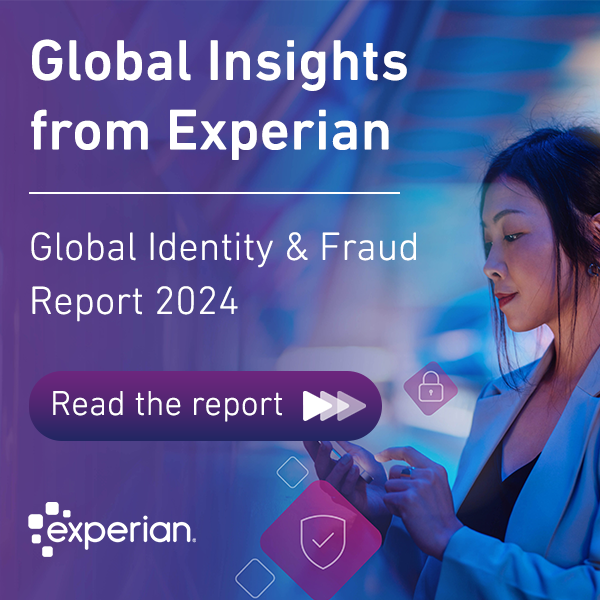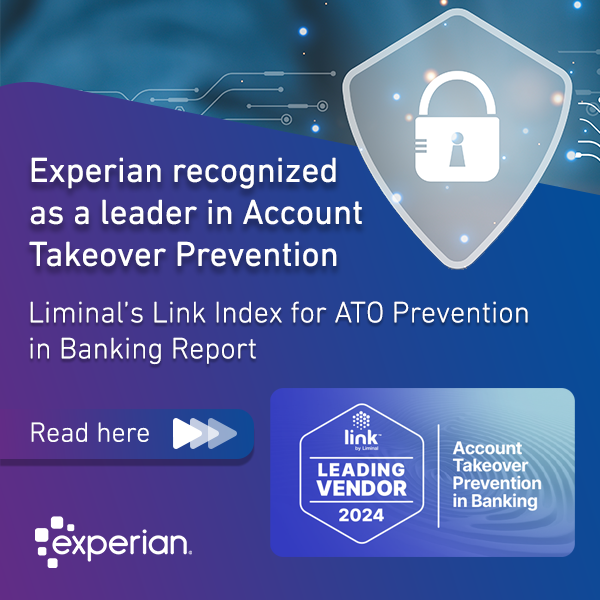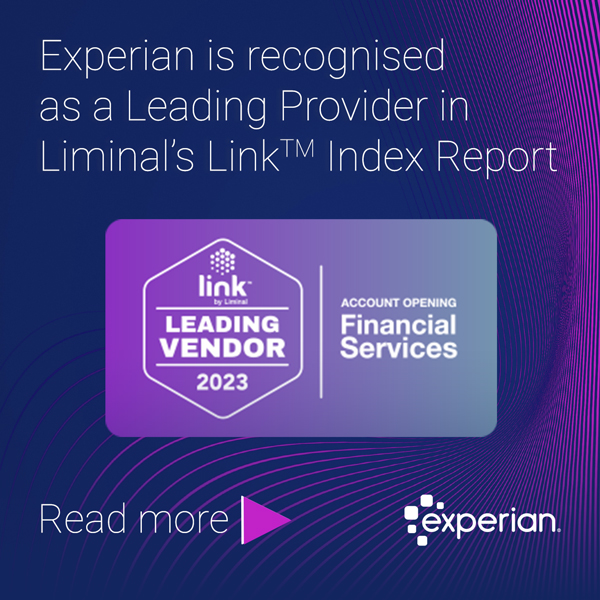Tag: Advanced analytics

By leveraging insights from leading industry analysts, Experian's expertise, extensive market studies, and market sentiment, we identified four key themes shaping the financial services sector this year. Read now Four themes impacting financial services this year: 1. Fraud evolution driven by AI Tracking synthetic identities is a big challenge for FIs in 2025, exacerbated by fraudsters' use of Gen AI tools to scale activities. Investment in AI is a growing priority as banks seek to strengthen identity verification. Account takeover (ATO) and Authorised Push Payment Fraud (APP) are also growing problems very much linked to advanced AI methods employed by criminals. Collaboration across institutions and the adoption of advanced analytics will be critical in staying ahead of fraudsters. 2. Advanced AI will improve operational efficiencies in new ways GenAI and Agentic AI (an orchestration tool connecting multiple AI models) are unlocking new levels of efficiency and personalisation. The emphasis on adoption is twofold: first, automating steps to accelerate development and delivery, and second, ensuring transparency, compliance, and governance. Businesses need to take an incremental approach to GenAI adoption, with centralised governance and a focus on explainability. AI will improve mid-office processes where internal manual inefficiencies impact downstream customer interactions. 3. Emergence of RegTech to meet complexities of compliance Heightened regulatory scrutiny is driving the adoption of innovative compliance technologies. Adopting cloud-native, modular systems supports more agile compliance strategies and reduces the cost and complexity of updating solutions. Explainable AI is increasingly essential for demonstrating compliance and fostering regulator confidence in automated decision-making. 4. Convergence of risk management The integration of fraud prevention, credit risk assessment, and compliance is a growing trend among financial institutions. Digital identity frameworks and unified data analytics are becoming essential for holistic risk management. Banks need to embrace collaborative approaches and consortium-level partnerships to address interconnected challenges. Read the report

Experian's new global report is now available on how businesses can enhance efficiency, insights, and growth through integration to transform the future of risk strategy. Download report In the ever-evolving financial landscape, the convergence of credit risk, fraud risk, and compliance is becoming a game-changer. Financial institutions (FIs) increasingly recognise the need to integrate these functions to enhance efficiency, gain deeper insights, and drive growth. The 2024 global report on the convergence of credit, fraud, and compliance sheds light on this critical transformation, emphasising how a unified strategy can revolutionise risk management. The report highlights the importance of convergence in shaping the future of financial services. We surveyed 750 leaders in credit risk, fraud risk and compliance in financial services organisations across the world. Inside the report: The need for convergence As technology advances, financial institutions (FIs) face the dual challenge of managing complex systems while simplifying consumer processes. The report reveals that organisations use an average of eight tools across credit, fraud, and compliance, with some using more than ten. This fragmentation leads to inefficiencies and increased risks.In addition, 79% of respondents want to work with fewer vendors to manage credit risk, fraud, and compliance, underscoring the need for streamlined operations. Independent evolution of functions and associated challenges Credit risk, fraud risk, and compliance functions have evolved independently, creating operational silos and technology management challenges. This separation has led to increased fraud and credit losses. The report highlights that only 9% of organisations prioritise these functions equally, with most focusing on fraud. However, 87% of respondents acknowledge the overlap between these areas and are working towards closer collaboration. Regulatory pressures and advanced fraud techniques New regulations in the US, UK, and EU are compelling FIs to reimburse consumers for losses due to scams, increasing the liability for both sending and receiving banks. Penalties for failing to implement effective Anti-Money Laundering (AML) solutions have also intensified. These regulatory demands and advanced fraud techniques necessitate a more integrated approach to risk management. Early stages of convergence While the market is beginning to recognise the benefits of convergence, many FIs are still in the early stages of this journey. The convergence speed varies, but mature organisations have already started or plan to start the process soon. The report shows that 91% of respondents believe that forward-looking companies will centralise these functions within the next three years. However, only 15% prefer a 'point solution', 36% prefer a single integrated solution, and 49% prefer modular integration. The role of technology Technology plays a crucial role in integrating functions and managing risk. Next-generation platforms are essential for adapting to market needs, delivering innovative products, and meeting regulatory requirements. The report emphasises the importance of data aggregation, which combines diverse data for deeper insights, and the integration of credit decisioning and fraud detection solutions to balance risk and growth goals simultaneously. Improving risk management through alignment Correctly identifying consumers, managing fraud risk, making informed credit decisions, and ensuring compliance share common ground. The report shows that 57% of respondents believe aligning credit risk, fraud, and compliance functions leads to better overall risk management. Businesses with more centralised practices report improved risk management effectiveness, operational efficiencies, and data integrity. Benefits of convergence The convergence of credit risk, fraud, and compliance offers numerous benefits, including: Improved risk management effectiveness: Better alignment leads to more effective risk management strategies. Operational efficiencies: Streamlined processes and reduced duplication of efforts enhance operational efficiency. Increased data integrity: Centralised data management ensures consistency and accuracy. Cost reduction: Consolidation of functions and technology reduces costs. Enhanced customer experience: A unified approach improves customer recognition and service across all channels. Read the report to find out how to prove value through integration. Download report

Using business and consumer quantitative and qualitative research from the UK, US, Brazil, EMEA, and APAC between 2023 and 2024, we assess the current global impact of fraud. Download now As 2024 draws to a close, businesses face an increasingly hostile environment in the battle against fraud. Driven by rapid technological advancement and evolving regulatory landscapes, organisations seek new ways to prevent and detect highly sophisticated attacks. Experian’s 2024 Global Fraud Report offers a deep dive into the current state of fraud, revealing critical insights and strategies businesses must adopt to stay ahead of fraudsters. Read the report to discover: Why security and customer experience are still in conflict In today’s digital age, businesses face the daunting task of balancing robust fraud prevention with a seamless customer experience. The report highlights that while stringent security measures are essential, unnecessary friction can drive customers away. A multi-layered approach to fraud prevention, integrating advanced technologies with customer-friendly practices, is crucial. The power of data sharing Data sharing has emerged as a powerful tool in the fight against fraud. By collaborating and sharing data across industries, businesses can gain a comprehensive view of fraud patterns and enhance their detection capabilities. Regulatory frameworks in regions like Brazil and the UK increasingly support data-sharing initiatives, which are vital for effective fraud prevention. What the rise in Authorised Push Payment Fraud means for businesses APP fraud has seen a significant rise in some parts of the world due to newly accessible GenAI tools enabling fraudsters to create more convincing scams at scale. Financial institutions are under pressure to implement measures to protect consumers and comply with new regulations that mandate reimbursement for APP fraud victims. How to uncover synthetic identities Synthetic identity fraud is a growing concern. The report reveals that advancements in GenAI have enabled the creation of highly realistic fake identities, making detection more challenging. Businesses need to invest in advanced analytics and alternative data sources to uncover synthetic identities effectively. Why AI and machine learning are critical to fraud prevention AI and machine learning are pivotal in modern fraud prevention strategies. The report underscores the necessity of these technologies in detecting and preventing fraud. AI and machine learning can analyse vast amounts of data to identify patterns and anomalies that may indicate fraudulent activity. Download the report to discover the 5 key takeaways to combat evolving fraud The 2024 Global Fraud Report reinforces the need for businesses to leverage advanced analytics, alternative data insights, data sharing, and a multi-layered approach to combat evolving fraud threats globally. Download report now About the research The 2024 Global Identity and Fraud Report uses the latest research from the United States, the United Kingdom, Brazil, EMEA, and APAC between 2023 and 2024 to examine fraud worldwide. The research provides combined insights globally from over 1,000 businesses and fraud leaders, as well as 4,000 consumers, focusing on fraud management and digital experience. See the report appendix for full details of the research.

In an era where businesses are inundated with data and options for consumer engagement, it is paramount to use sophisticated targeting techniques that reach and resonate deeply with the intended audience. Pre-screen targeting solutions are becoming increasingly sophisticated, offering a strategic advantage by enabling more precise and impactful outreach, especially within the financial services sector. Technological evolution and targeting precision The core innovation behind pre-screened targeting solutions is extensive data analytics and predictive modelling. These systems integrate detailed consumer data, such as purchasing behaviors and credit scores, with advanced algorithms to identify potential customers most likely to respond positively to specific promotional campaigns. This methodological approach streamlines campaign efforts and enhances each interaction's accuracy and tactical effectiveness. Effective targeting with direct mail Understanding the dynamics of various targeting channels is crucial for deploying effective strategies. In the competitive landscape of financial services in North America, direct mail has been shown to have distinct advantages. Direct mail offers substantial engagement. For credit products, this is typically 0.2-2% for prime consumers and 1-3% for near prime and subprime consumers**. This channel’s effectiveness stems from its tangible nature, which cuts through digital clutter and captures consumer attention. Benefits of pre-screened targeting solutions Maximized response rates—Direct Mail response models can dramatically boost prospect response rates by targeting a well-defined, high-propensity audience likely to be interested in specific offers. Using a custom response model could improve the average response rate of pre-screen direct mail campaigns by 10-25%**. Reduced risk—Traditional broad-spectrum marketing campaigns waste resources on uninterested parties. Pre-screened targeting via direct mail aims to gain the right through-the-door prospects, minimizing the risk of fraud and delinquencies, thus leading to significant cost savings on underwriting costs. Enhanced customer engagement and retention—Targeted and personalized direct mail strengthens customer relationships by making recipients feel valued. This leads to higher engagement and loyalty, essential for long-term business success. Robust compliance and enhanced security—Pre-screened solutions simplify adherence to industry regulations and consumer privacy standards. These systems come equipped with compliance safeguards that help prevent data breaches and ensure that all communications meet regulatory standards, which is especially critical in the highly regulated financial sector. Looking forward: The strategic imperative of advanced targeting and optimization As markets evolve, the strategic importance of deploying precise and efficient marketing techniques will only grow. Financial institutions harnessing pre-screened targeting and optimization solutions gain a significant competitive edge, achieving higher immediate returns and long-term customer loyalty and brand strength. Optimization ensures that the right customer prospects are targeted and done within business constraints such as resources and direct mail budgets. Future enhancements in AI and machine learning are expected to refine the capabilities of pre-screened targeting solutions further, offering even more sophisticated tools for marketers to engage with their target audiences effectively. For businesses aiming to lead in efficiency, customer satisfaction, and innovation, adopting advanced pre-screened targeting solutions is not just an option—it’s a necessity for staying relevant in a crowded and competitive marketplace. About Ascend Intelligence ServicesTM (AIS) Target AIS Target is a sophisticated pre-screening solution that boosts direct mail response rates. It uses comprehensive trended and alternative data, capturing credit and behavior patterns to iterate through direct mail response models and mathematical optimization. This enhances the target strategy and maximizes campaign response, take-up rates, and ROI within business constraints. Find out more ** Experian Research, Data Science Team, July 2024

How predictive modelling and optimization can maximize recovered amounts with a focus on Next Best Action assignment. In 2023, the US economy outperformed expectations, with strong job growth, impressive GDP (annual growth rate was 2.5%, up from 1.9% in 2022), and lower inflation. Increased consumer spending and reduced trade deficit highlighted its resilience and adaptability, fostering a stable economic environment. However, the story around consumer debt and delinquencies has not been so positive. In the latest quarterly report on household debt and credit released in February 2024 by the Federal Reserve Bank of New York, total household debt saw a notable increase of $212 billion (1.2%) in the fourth quarter of 2023, reaching $17.5 trillion. Within this surge, credit card balances increased by $50 billion, alongside mortgage balances which rose by $112 billion to hit $12.12 trillion. Auto loans, which have been trending upwards since 2011, saw an additional $12 billion increase, totalling $1.61 trillion. Other balances, encompassing retail cards and various consumer loans, witnessed a growth of $25 billion. Despite the economic recovery post-Covid, the level of debt in credit cards and auto loans, transitioning into delinquency remains higher than pre-pandemic levels. In Q4 2023, aggregated delinquency rates reached 3.1%, signifying a persistent financial strain for many lower income households. Transition rates into delinquency increased across all debt categories except for student loans. Approximately 8.5% of credit card balances and 7.1% of auto loans transitioned into delinquency on an annualised basis. Serious credit card delinquencies (90 days +) surged across all age groups, especially among younger borrowers, surpassing pre-pandemic levels. With such elevated debt and early-stage delinquency rates, lenders face many challenges. We look at how predictive modelling and optimization can maximize recovered amounts with a focus on Next Best Action assignment. Collections managers and teams within financial institutions face a range of challenges in maintaining portfolio growth while effectively managing increases in early-stage delinquencies. The top five challenges include: 1. High operating costs Contacting delinquent customers, negotiating payments, and managing recovery efforts entail labor-intensive and costly processes. This encompasses expenses related to staffing call centres, sending mailers, and deploying collections management software. 2. Regulatory compliance Navigating federal, state, and local regulations governing debt collection practices presents a complex challenge. Compliance with laws such as the Fair Debt Collection Practices Act (FDCPA) and the Telephone Consumer Protection Act (TCPA) is imperative, dictating the permissible methods and timing of borrower contact. 3. Customer retention and satisfaction Balancing effective debt recovery with maintaining positive customer relationships is essential. Employing aggressive collection tactics risks damaging customer relationships and tarnishing brand reputation, potentially impacting long-term customer retention. 4. Technological integration Incorporating modern technologies like machine learning, and automation into the collections process can enhance efficiency but poses implementation challenges. These technologies require substantial investment and expertise to streamline operations effectively. 5. Data management and predictive analytics Efficiently managing and analyzing vast amounts of data to identify at-risk accounts early and customise collection strategies is a significant endeavour. Accurate data analysis is pivotal for predicting delinquencies likely to self-cure and determining appropriate contact channels, such as; SMS, Email, Phone, Outbound IVR or social media. Applying a customer-centric, strategic approach These challenges underscore the critical need for credit lenders to adopt strategic, compliant, and customer-centric approaches to early-stage delinquency management. Currently, financial institutions use a multitude of strategies to maximize revenue collection. These range from data-driven customer segmentation to profile customers, Regulatory Technology (RegTech) for compliance, proactively identifying vulnerable customers needing financial relief, offering flexible repayment solutions and predictive modelling. Some credit lenders are also using machine learning models, such as Next Best Action (NBA) to personalize collection strategies based on customer behaviour, financial status, and communication preferences. This approach predicts recovery rates by tailoring channel contact to each individual customer in the most effective way. However, NBA models alone are not enough. To maximise collections, within known business constraints (call centre resources, budget, regulations), NBA needs to be augmented with non-linear optimization techniques to ensure not only the right communication preferences are adhered to, but also the business constraints mentioned above. Without the optimisation component businesses are left with NBA modelling that is unadjusted for business constraints. Next Best Action (NBA) Optimization NBA optimization presents a game-changing opportunity for lenders, particularly given the current economic challenges consumers are facing. Here's how NBA optimization can drive value: Personalized communication NBA optimization uses sophisticated customer modelling to pinpoint the most effective communication channels for each borrower, be it email, text, phone, or another preferred method. By personalizing communications, lenders significantly increase the chance of response and engagement from customers, which will also streamline the collections process with greater efficiency and reduced intrusion. Dynamic strategy adjustment NBA solutions continuously learn from outcomes, enabling strategy adjustments. This dynamic capability empowers lenders to swiftly adapt to changing economic conditions, borrower behaviours, and regulatory landscapes, ensuring the maintenance of effective collections practices. Optimized timing Leveraging predictive modelling, NBA optimization empowers lenders to identify the best times to contact their customers. This strategic approach ensures their communication attempts yield higher success rates, minimizing the need for repeated contacts and reducing operational costs. Regulatory compliance NBA optimization solutions can be configured to seamlessly adhere to regulatory requirements, including permissible contact times and frequency limits. This automation ensures compliance, protecting lenders from legal penalties and upholding their standing with regulatory bodies. Operational efficiency Through automated decision-making processes, NBA optimization assists lenders in allocating resources more thoughtfully. By prioritizing accounts with higher payment probabilities and determining the most cost-effective collection strategies, lenders can streamline operations and minimize costs. Improved customer experience (CX) NBA optimization facilitates a tailored approach to debt collection, significantly enhancing the borrower's experience. By considering the borrower's unique circumstances and preferences, lenders can offer more relevant and flexible repayment options, while also boosting customer satisfaction and loyalty. By implementing NBA optimization customised to channel contact preferences and operational constraints, lenders can navigate the complexities of early-stage collections with precision. This strategic approach not only addresses operational challenges but also aligns with the evolving expectations and financial pressures of consumers, leading to improved outcomes for both lenders and borrowers. Businesses can assign the most profitable, cost-effective treatment and channel to contact customers. Ascend Intelligence Services™ Collect delivers an optimized collections decision strategy, driven by predictive analytics, that determines the next best action and contact channel for each individual customer to improve recovery rates, increase efficiency, and stay within day-to-day constraints and regulatory requirements. Find out more

Lenders prioritise automation above all, according to research. In a study conducted by Forrester Consulting on behalf of Experian, we surveyed 660 and interviewed 60 decision makers for technology purchases that support the credit lifecycle at their financial services organisation. The study included businesses across North America, UK and Ireland, and Brazil. Research from Forrester on behalf of Experian found that automation is the top priority for businesses, and regardless of the specific industry or region, decision-makers consistently identified it as an important area of focus, and the biggest challenge. Lenders are using automation across the credit lifecycle and intend to invest further in the next 12 months, but there are multiple barriers to enhancing automation. We look at the use cases for automation and address the key challenges lenders face when automating decisions. The automation agenda The interpretation and application of automation vary hugely across the maturity spectrum of businesses in our research. While some companies consider automation as a means of simplifying tasks, such as the transition from manual processes to electronic spreadsheets, others are embracing its more advanced forms, such as AI-powered models. Use cases for automation in lending Customer service chatbots using Natural Language Processing (NPL) combined with Robotic Process Automation system (RPA). Remote verification of customers using machine vision and RPA to cross-check data. Data governance - data cleansing of personal information from within data using RPA and NPL. Operational efficiencies using process mining and AI to identify automation opportunities. Credit and fraud risk decisioning, using machine learning. Automation is about making processes as slick and robust as possible, giving the consumer a rapid journey so they can get processed very quickly, while behind the scenes lenders are making the best possible, compliant decisions, that protect them from losses around both credit risk and fraud.Neil Stephenson, Vice President of Experian SOFTWARE SOLUTIONS CONSULTANCY The changing face of automated decision-making in line with rapid tech advancements makes the use of automation by lenders a more complex opportunity than most. On one side there is the chance to enhance models with AI-powered tools to take away manual and subjective decision-making from processes. On the other, there’s the issue of governance and compliance – how to explain models that remove humans altogether. Introducing automation into some parts of the credit lifecycle isn’t always straightforward. Customer management has benefited from a lot of investment in the automation space over the years, particularly Natural Language Processing (NLP), but according to our research, the priority for business investment for Robotic Process Automation (RPA) in the next 12 months is originations. With onboarding playing such a key role in both customer experience and portfolio growth, businesses are looking to enhance this part of the credit lifecycle with automation. Customer experience is driving growth Automation plays a pivotal role in improving the customer journey and experience. The research showed that enhancing customer experience ranked even higher than growth as a priority for many organisations. As businesses strive to deliver seamless and personalised interactions, automation provides the necessary foundation for digital success, which in turn can strengthen competitiveness while retaining valuable customers. "Strategically investing in automation offers businesses the opportunity to scale operations, with a primary focus on growth. In times of economic uncertainty, more targeted, customer-centric strategies, that encompass more accurate predictive models, built on up-to-date samples and executed rapidly, can help mitigate a higher-risk lending backdrop." says Neil Stephenson, Vice President of Experian Software Solutions Consultancy. "Customer experience is the battleground for businesses, where they compete to deliver the best digital journeys in the market. It's a battleground that isn’t just about increasing revenue – the market perception of an organisation can be as important as growth in some portfolios because businesses have a reputation to protect." Automating decisions can ensure customer experience is truly seamless, but businesses face multiple barriers when it comes to credit and risk decision automation. Reducing referred applications From scoring regression models to the development of machine learning models, better and smarter analytics are critical to drive the processes responsible for making application decisions. Reducing referred applications in turn decreases the need for manual intervention. By minimising the volume of applications in the middle of the credit score, lenders have a clearer and ultimately more automated approach to application accepts and declines. We interviewed decision-makers to understand the numerous challenges faced by lenders when automating decisions: Increasing data sources to allow for a more complete picture of the consumer Improved data quality, and increased volume of data Prevention of model bias The complexity of consumer type attached to some products Redundancy in data input and analytics Training across key roles for a better understanding of automation capabilities Explaining decisions based on machine learning models to regulators Complex fraud referral processes For many respondents, automation is about accuracy and efficiency. By improving automation, there are fewer instances of errors and delays. To ensure scalability can exist in consistent, compliant, and accurate processes that work for both the business and the consumer, here are 10 tips to help tackle the challenges faced by lenders when it comes to automating decisions: Embrace advanced data aggregation tools and technologies that can efficiently collect and integrate data from various sources. Partner with known, trustworthy data providers to enrich datasets. Explore the use of no-code data management tools that allow users to add and remove data sources more quickly and easily. Implement data quality processes. Regularly audit and clean data to remove inconsistencies. Move to cloud-based solutions for scalable data storage and processing of very large datasets. Regularly audit (monitor) machine learning models for bias. Eliminating sampling bias is not yet possible but using a range of datasets (samples) and various sampling techniques will ensure representation across different demographics to help minimise bias. Develop specific models for different consumer segments or product categories. Regularly update models based on evolving consumer trends and behaviours. Conduct a thorough analysis of data inputs and streamline redundant variables. Use feature selection techniques such as correlations, weight of evidence, and information value to identify the most relevant information. Foster a culture of continuous learning and collaboration for all key stakeholders involved in the credit decisioning and strategy process. Develop transparent models with explainable features. Use interpretable machine learning algorithms that allow for clear explanations of decision factors at the customer level. Streamline identity verification processes by using smart orchestration to reduce false positives and prevent fraud. More on automated decision-making from PowerCurve – North America More on automated decision-making from PowerCurve – UK Related content: Digital decisioning

Authorised Push Payment fraud is growing, and as regulators begin to take action around the world to try to tackle it, we look at what financial institutions need to focus on now. APP fraud and social engineering scams In recent years, there has been a significant surge in reported instances of Authorized Push Payment Fraud (APP). These crimes, also known as financial scams, wire fraud scams, or social engineering scams in different parts of the world, refer to a type of fraud where criminals trick victims into authorising a payment to an account controlled by the fraud perpetrator for what the victim believes to be genuine goods or services in return for their money. Because the transactions made by the victim are usually done using a real-time payment scheme, they are often irrevocable. Once the fraudster receives the funds, they are quickly transferred through a series of mule accounts and withdrawn, often abroad. Because APP fraud often involves social engineering, it employs some of the oldest tricks in the criminal's book. These scams include tactics such as applying pressure on victims to make quick decisions, or enticing them with too-good-to-be-true schemes and tempting opportunities to make a fortune. Unfortunately, these tricks are also some of the most successful ones, and criminals have used them to their advantage more than ever in recent times. On top of that, with the widespread adoption of real-time payments, victims have the ability to transfer funds quickly and easily, making it much easier for criminals to take advantage of the process. APP Fraud and social engineering scams - cases and losses across the globe: View map Impact of AI on APP fraud Recent advancements in generative artificial intelligence (Gen AI) have accelerated the process used by fraudsters in APP fraud. Criminals use apps like Chat GPT and Bard to create more persuasive messages, or bot functionality offered by Large Language Models (LLMs) to engage their victims into romance scams and the more sophisticated pig butchering scams. Other examples include the use of face swapping apps or audio and video deepfakes that help fraudsters impersonate someone known to their victims, or create a fictitious personality that they believe to be a real person. Additionally, deepfake videos of celebrities have also been commonly used to trick victims into making an authorised transaction and lose substantial amounts of money. Unfortunately, while some of these hoaxes were really difficult to pull off a few years ago, the widespread availability of easy-to-use Gen AI technology tools has resulted in an increased number of attacks. A lot of these scams can be traced back to social media, where the initial communication between the victim and criminal takes place. According to UK Finance, 78% of APP fraud started online during the second half of 2022, and this figure was similar for the first half of 2023 at 77%. Fraudsters also use social media to research their victims which makes these attacks highly personalised due to the availability of data about potential targets. Accessible information often includes facts related to family members, things of personal significance like hobbies or spending habits, information about favourite holiday destinations, political views, or random facts like favourite foods and drink. On top of that, criminals use social media to gather photos and videos of potential targets or their family members that can later be leveraged to generate convincing deepfake content that includes audio, video, or images. These things combined contribute to a new, highly personalised approach to scams than has never been seen before. What regulators are saying around the globe APP fraud mitigation is a complex task that requires collaboration by multiple entities. The UK is by far the most advanced jurisdiction in terms of measures taken to tackle these types of fraud to help protect consumers. Some of the most important legislative changes that the UK’s Payment Systems Regulator (PSR) has proposed or introduced so far include: Mandatory reimbursement of APP scams victims: A world first mandatory reimbursement model will be introduced in 2024 to replace the previous voluntary reimbursement code which has been operational since 2019. 50/50 liability split: All payment firms will be incentivised to take action, with both sending and receiving firms splitting the costs of reimbursement 50:50. Publication of APP scams performance data: The inaugural report was released in October, showing for the first time how well banks and other payment firms performed in tackling APP scams and how they treated those who fell victim. Enhanced information sharing: Improved intelligence-sharing between PSPs so they can improve scam prevention in real time is expected to be implemented in early 2024. Because many of the scams start on social media or in fake advertisements, banks in the UK have made calls for the large tech firms (for example, Google, Facebook) and telcos to be included in the scam reimbursement process. As a first step to offer more protection for customers, in December 2022, the UK Parliament introduced a new Online Safety Bill that intends to make social media companies more responsible for their users’ safety by removing illegal content from their platforms. In November 2023, a world-first agreement to tackle online fraud was reached between the UK government and some of the leading tech companies - Amazon, eBay, Facebook, Google, Instagram, LinkedIn, Match Group, Microsoft, Snapchat, TikTok, X (Twitter) and YouTube. The intended outcome is for people across the UK to be protected from online scams, fake adverts and romance fraud thanks to an increased security measures that include better verification procedures and removal of any fraudulent content from these platforms. Outside of the UK, approaches to protect customers from APP fraud and social engineering scams are present in a few other jurisdictions. In the Netherlands, banks reimburse victims of bank impersonation scams when these are reported to the police and the victim has not been ‘grossly negligent.’ In the US, some banks provide voluntary reimbursement in cases of bank impersonation scams. As of June 2023, payment app Zelle, owned by seven US banks, has started refunding victims of impersonation scams, thus addressing earlier calls for action related to reported scams on the platform. In the EU, with the newly proposed Payment Services Directive (PSD3), issuers will also be liable when a fraudster impersonates a bank’s employee to make the user authenticate the payment (subject to filling in a police report and the payer not acting with gross negligence). In October 2023, the Monetary Authority of Singapore (MAS) proposed a new Shared Responsibility Framework that assigns financial institutions and telcos relevant duties to mitigate phishing scams and calls for payouts to be made to affected scam victims where these duties are breached. While this new proposal only includes unauthorised payments, it is unique because it is the first such official proposal that includes telcos in the reimbursement process. Earlier this year, the National Anti-Scam Centre in Australia, announced the start of an investment scam fusion cell to combat investment scams. The fusion cell includes representatives from banks, telcos, and digital platforms in a coordinated effort to identify methods for disrupting investment scams to minimise scam losses. To add to that, in November 2023, Australian banks announced the introduction of confirmation-of-payee system that is expected to help reduce scams by ensuring customers can confirm they are transferring money to the person they intend to, similarly to what has been done in the UK a few years ago. Finally, over the past few months, more jurisdictions such as Australia, Brazil, the EU and Hong Kong, have announced either proposals or the roll out of fraud data sharing schemes between banks and financial institutions. While not all of these schemes are directly tied to social engineering scams, they could be seen as a first step to tackle scams together with other types of fraud. While many jurisdictions beyond the UK are still in the early stages of the legislative process to protect consumers from scams, there is an expectation that regulatory changes that prove to be successful in the UK could be adopted elsewhere. This should help introduce better tracking of the problem, to stimulate collaboration between financial insitutions, and add visibility of financial instituitions efforts to prevent these types of fraud. As more countries introduce new regulations and more financial institutions start monitoring their systems for scams occurrences, the industry should be able to achieve greater success in protecting consumers and mitigating APP fraud and social engineering scams. How financial institutions can prevent APP fraud Changing regulations have initiated the first liability shifts towards financial institutions when it comes to APP fraud, making fraud prevention measures a greater area of concern for many leaders in the industry. Now the responsibility is spreading across both the sending and receiving payment provider, they also need to improve monitoring for incoming payments. What’s more, as these types of fraud are a global phenomenon, financial institutions from multiple jurisdictions might consider taking greater fraud prevention steps early on (before regulators impose any mandatory rules) to keep their customers safe and their reputation high. Here are five ways businesses can keep customers safe, while retaining brand reputation: Advanced analytics – advanced data analytics capabilities to create a 360° of individuals and their behaviour across all connected current accounts. This supports more sophisticated and effective fraud risk analysis that goes beyond a single transaction. Combining it with a view of fraudulent behaviours beyond the payment institution's premises by adding the ability to ingest data from multiple sources and develop models at scale allows businesses to monitor new fraud patterns and evolving threats. Behavioural biometrics – used to provide insights on indicators such as active mobile phone calls, session length, segmented typing, hesitation, and displacement to detect if the sender is receiving instructions over the phone or if they show unusual behaviour during the time of the transaction. Transaction monitoring and anomaly detection – required to monitor sudden spikes in transaction activity that are unusual for the sender of the funds as well as mule account activity on the receiving bank’s end. Fraud data sharing capabilities – sharing of fraud data across multiple organisations can help identify and stop risky transactions early, in addition to mitigation of mule activity and fraudulent new accounts opening. Monitoring of newly opened accounts – used to detect fake accounts or newly opened mule accounts. By leveraging a combination of these capabilities, financial institutions will be better prepared to cope with new regulations and support their customers in APP fraud. Identity & Fraud Report 2023 US Identity & Fraud Report 2023 UK Defeating Fraud Report 2023 EMEA & APAC

What are lenders prioritising when it comes to Gen AI? We take a look at five transformative use cases in lending, and organisational priorities for integrating Gen AI into customer lifecycle processes. Although Generative Artificial Intelligence (Gen AI) only launched publicly in the form of Chat GPT last November, adoption has been widespread and rapid. Even in typically risk-adverse industries like financial services, our research shows that there is widespread recognition that Gen AI could deliver a range of benefits across business functions. We identified five areas of focus for lenders based on our research. In a study conducted by Forrester Consulting on behalf of Experian, we surveyed 660 and interviewed 60 decision makers for technology purchases that support the credit lifecycle at their financial services organisation. The study included businesses across North America, UK and Ireland, and Brazil. The qualitative research showed that lenders are already using a type of Gen AI, Large Language Models (LLMs), in their operations, with a focus on testing across areas such as customer service and internal processes before deploying to credit operations. We look at the potential use cases, and how businesses are using Gen AI now. 1. Personalised customer experience Customers today expect a personalised lending experience that is tailored to their unique needs and preferences. GenAI can leverage customer data to generate personalised loan offers, recommendations, and repayment plans. This helps lenders improve customer satisfaction and loyalty, leading to increased customer retention and revenue growth. This is an area that is front of mind for the companies in our research – nearly half of businesses surveyed are planning to implement or expand technology capabilities to either upsell or retain customers in the next 12 months. Furthermore, 50% of companies believe that offering more tailored underwriting and pricing is a top priority in their credit operations, followed by 44% who also aim to increase personalisation in marketing, products, and services to their customers. According to the research, some organisations have formed alliances with technology providers like OpenAI and Microsoft to investigate and further explore the use of LLMs. These partnerships involve analysing customer data to identify opportunities for cross-selling. 2. Enhancing models with new data sources With new data sources emerging all the time, Gen AI is one of the technologies that will most likely accelerate the opportunity for businesses to incorporate them into models. Lenders could include sources such as social network data into their models by using LLMs. This unstructured data, including customer emotions and behaviours on social networks, would be treated as an additional variable in the models. According to the research social media data and psychometric data is already used across financial services, to varying degrees. It showed that 35% of retail companies use social media data, while 29% of FinTechs use psychometric data. Auto finance companies sit at lower end of the adoption scale, with only 12% using social media data and 15% psychometric data. 3. Operational efficiencies Gen AI can help bring operational efficiencies to customerjourneys across the entire lifecycle, offering lenders theability to automate and streamline various processes,resulting in improved productivity, cost savings, andenhanced customer experiences. One of the top challenges for businesses surveyed isimproving customer journeys during onboarding, and thiswas particularly significant for credit unions / buildingsocieties (53%). 4. Detecting and preventing fraud Gen AI can play a crucial role in fraud detection by analysing patterns and anomalies in vast datasets. By leveraging machine learning techniques, Gen AI models can proactively identify potentially fraudulent activities and mitigate risks. The ability to detect fraud in real-time improves the overall security of lending operations and helps protect lenders and borrowers from financial losses. Detecting and preventing fraud is a constant challenge for lenders. 51% of retailers and 47% of credit unions/ building societies surveyed said that reducing fraud losses is a key challenge for them. 5. Customer service Driven by advances in the machine learning and AI space, the world of customer service has benefited hugely from the adoption of virtual assistants and chatbots in recent years. This looks to continue, with businesses saying that LLMs are being tested for customer service purposes, allowing lenders to identify customer issues and automate actions. What's next for lenders? The research found that lenders are utilising various machine learning techniques like regression, decision trees, neural networks, and random forest, along with LLMs. Businesses are in the early stages of exploring how they can use LLMs in credit risk models, but it will undoubtedly involve a blend of existing and new capabilities. As with any emerging technology, it’s important to look at potential risk. The research indicated that organisations see challenges and concerns when it comes to the use of LLMs in their models. It is crucial to ensure the models are trusted, validated, and properly understood to avoid reliance on outsourced solutions and maintain control and visibility over the models’ functions. The ability to explain decisions in Gen AI to avoid bias can be difficult, and businesses will be watching the regulators to understand how best to proceed. There is no doubt, however, that Gen AI will optimise the credit customer lifecycle, creating vast opportunities for lenders. Download PDF More on Gen AI

In a study conducted by Forrester Consulting on behalf of Experian, we surveyed 660 and interviewed 60 decision makers for technology purchases that support the credit lifecycle at their financial services organisation. The study included businesses across North America, UK and Ireland, and Brazil. More on Gen AI

With an ever-growing number of data sources, businesses must be able to rapidly access and integrate them into decisioning processes using no-code tools to stay ahead of the competition. Today’s customer journey has become increasingly sophisticated. As most firms that interact with customers can attest, this journey is a dynamic process shaped by a range of decisions. Businesses need to decide what is the most compelling offer to deliver to a new customer. Should you approve their loan application? Could the customer gain more from sustainability-linked loans or greener mortgages? What is rich data? These diverse decisions are ideally informed by rich data. This is all the available data, including new data derived from analytics using advanced techniques such as Machine Learning and using rules to make predictions and to calculate scores. While most firms have this data, it is difficult to gather, prepare and integrate into the decisioning processes. Multiplicity of data sources Data types and sources are growing. With regulatory bodies gradually approving the use of more data globally, businesses are faced with an opportunity dressed up as a challenge. Speedy integration of different data sources gives organizations a competitive edge, so finding vendors that can enable firms to utilize available data will positively impact them from a cost efficiency perspective, while also creating the potential for revenue growth. The future is to empower business users with no-code data management No-code data management capabilities add a whole new meaning to self-sufficiency for businesses. It will enable teams across organizations to rapidly change data-driven strategies without much vendor involvement. Gartner estimates that by 2025, 70% of new applications developed by enterprises will use low-code or no-code technologies, up from less than 25% in 2020. Moving towards client self-service with no-code capabilties is the goal of most businesses. These capabilities are already allowing teams supporting clients to rapidly integrate data sources into their solutions, providing the perfect test ground for business user enablement. If a decision strategy requires changes and a new data source, PowerCurve users can quickly adapt. They can now gather and prepare the right data and deliver it to the system within days. These changes can be instantly published through secure and easily adjustable APIs that support the latest industry standards and frameworks such as OpenAPI and OAuth. An effective customer journey relies on informed decisions and these decisions rely on the right data and advanced analytics. While Experian's PowerCurve platform is well known for automating a range of decisions across the customer lifecycle, it is the data integration capabilities that ensure these decisions are informed by rich data and insights. Creating a harmonious relationship that produces superior and trustworthy results for businesses. No-code data management enables businesses with easy and rapid data source access to deliver rich and insightful data to decisioning processes.

Latest Global Insights Report: How supporting consumers in a time of uncertainty can help businesses adapt and grow A changing economic landscape needs a new approach The new digital consumer is here to stay and they expect businesses to support them with the products and services they need to navigate the rising cost of living, in a secure digital world personalised to them. Find out how: Our latest research reveals how economic uncertainty is evolving the experiences and expectations of digital consumers. From increasing the demand for credit options and financial inclusion, to deepening the need for trust, security and being seen. Read the report to find out how businesses can benefit from responding to changing consumer needs - including the additional tools and resources consumers and businesses may need to maintain financial health: What do digital consumers want? The global economy is under pressure with inflation raising prices across the world. In response, consumer behaviour is shifting, as people tackle the increased cost of living, and the prospect of an economic downturn. Digital consumers are continuing to manage their lives online and are expecting businesses to take the lead on improving the digital environment. A quality online experience is paramount, or consumers will move on. 1 in 4 businesses lost more than 10% of their customers in 2021, due to “suboptimal” digital experiences. A range of payment options including BNPL As prices rise, consumers are expecting to spend more online and are looking for varied credit options to help manage their finances. The demand for buy-now-pay-later (BNPL) options is also growing, with more consumers using BNPL to buy household staples. Consumers look favourably on companies that offer BNPL, but companies will have to find the right balance between supporting customers and managing credit risk. 32% of BNPL purchases were for groceries, up from 27% in March. Financial inclusion Economic uncertainty is accelerating the need for greater financial inclusion. Businesses need to find more creditworthy consumers and support them with responsible and sustainable products and services. 1 in 3 businesses is in the process of rolling out financial inclusion initiatives Security and trust As consumer need increases, so does fraud, including cost of living scams. Security is now a top priority for consumers around the world, alongside privacy, convenience and personalisation. 50% of consumers say they’re concerned about their online transactions. However, trust in emerging customer recognition tools is increasing, with consumers’ top three including physical biometrics, PIN codes and behavioural biometrics. Personalisation Consumers who trust businesses are more willing to share their data, enabling companies to create more personalised experiences, which in turn, improves consumer trust. 46% of consumers say that personalisation (receiving offers that fit their needs) is the most important aspect of their online experience. Read our report to discover the challenges and opportunities facing consumers and businesses and the tools, resources and strategies that can help your company get ahead. The survey results represent 6,000 consumers and 2,000 businesses across 20 countries, including Australia, Brazil, Chile, China, Columbia, Denmark, Germany, India, Indonesia, Ireland, Italy, Malaysia, Netherlands, Norway, Peru, Singapore, South Africa, Spain, UK, and US. Read our report

Experian’s latest research shows that the crisis of the past few years has yielded a new, savvier digital consumer. With the rapid move to online services amidst the pandemic, consumers worldwide adapted—and quickly. Fifty-three per cent of consumers say they have increased their online spending and transactions within the past three months, and 50% plan to increase it even more over the next few months. As online activity has surged, so too have consumer expectations for friction-free, secure transactions. More than 80% of consumers say a positive online experience makes them think more highly of the brand. And if businesses don't meet those expectations? Well, switching providers is only becoming easier . For financial service providers, the evolution of consumer behaviour presents both an opportunity and a challenge. It's never been more critical to ensure that digital experiences are convenient and frictionless. However, soon that will be the expectation and not the draw for new customers. Instead, finding unique ways to compete will be what separates the good from the great. Convenience versus risk In our latest survey, consumers ranked security, convenience, and ease of recognition as the top contributors to a positive online experience. All of these are vital components to providing a frictionless transaction. However, seamlessly logging in to a financial app, applying for credit, or managing a balance isn't yet the standard for every provider. Many traditional banks continue to play catch-up with digital upstarts, but consumers are becoming less tolerant of barriers to accessing services and products, with 23% saying that businesses aren’t meeting their expectations for digital experiences. This provides businesses with the opportunity to attract and retain new customers, especially those tired of manual account onboarding processes. For instance, leveraging emerging recognition tools adds to the convenience factor, limiting the time customers spend inputting data and streamlining the entire experience. But even as they continue to prioritise frictionless processes, businesses should be wary of sacrificing security or increasing their own risk. In our survey, 73% of consumers said that the onus is on businesses to protect them online. While they don't want security efforts that slow down their transactions, they expect the level of security to remain high nonetheless. On the business side, we've also seen providers creating friction-free options for lending—for example, in the Buy Now, Pay Later (BNPL) space—that enable consumers to access credit nearly immediately. But even with the convenience, there is still a need to manage affordability and ensure that these customers aren't introducing additional risk to credit models. Differentiate to retain customers: The growing role of rewards With all the innovation underway, a friction-free experience will become the standard. And it may already be so among digital-first businesses. This begs the question: If a secure, convenient experience is the norm for consumers, then how can businesses differentiate themselves? The next competitive differentiator will be how businesses reward customers for their loyalty. It's no longer enough to provide new customers with low-interest or no-interest credit on small purchases. Forward-looking financial services providers are getting far more creative with their rewards. For instance, businesses offering BNPL are enabling their customers to accumulate loyalty points for using the service with multiple retailers. Customers can then put those points to use as discounts on merchandise from the places they already love to shop. Data sharing and analytics play a significant role in this approach, allowing businesses to understand their customers' behaviours and personalise offers and rewards. Notably, our survey reveals that 83% of consumers say their awareness of how companies use their personal data for security, convenience, and personalisation has increased. Today's consumers are as digital as ever, and there's no going back. While friction-free may have been the differentiator before, it's rapidly becoming the standard. Going forward, financial services providers will need to find a new way to compete for savvy consumers who expect—and demand—secure, frictionless online experiences. Stay in the know with our latest research and insights:




